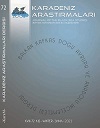Tarihsel Türk Dili Metinlerinde Bir Gramerleşme Örneği: Oksuz ve Bazı İkileme Şekilleri
An Example of Grammarization in Historical Turkic Texts: On Oksuz and Its Some Forms of Hendiadyoins
Author(s): Kenan AzılıSubject(s): Cultural history, Language acquisition, Turkic languages
Published by: Karadeniz Araştırmaları Merkezi
Keywords: Old Turkic; Grammarization; Hendiadyoins; Oksuz;
Summary/Abstract: Turkic – ever since it the dawn of its existence – has had a rich textual cannon hailing from different circles of culture. Such a cannon moreover features a very rich vocabulary. Many archaic Turkic words have made their reached modern written languages a wide geography – many of which date as far back as the twelfth century. That noted, some pose problems for linguists when it comes to explaining their morphology. In the context of historical texts, the use of comparative linguistics can help us solve a good number of these, but not all. In that respect, certain words need to be re-assessed from different angles and with different approaches. The form “oksuz” has been widely studied by Turkologists, and yet still remains an enigma despite researchers attempts at explaining it. Many have tried to analyse it through examples taken from Buddhist Uyghur inscriptions. Alas, they remain dubious. This article will attempt to examine “oksuz” in a conceptual light, as it appears in historical texts – from the earliest examples we have of it, to its hendiadyoin forms. We will do this by studying how it evolved grammatically – stage by stage – and propose a new interpretation.
Journal: Karadeniz Araştırmaları
- Issue Year: 2021
- Issue No: 72
- Page Range: 1001-1010
- Page Count: 10
- Language: Turkish

